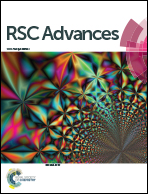Structural, magnetic and electronic properties of iron doped barium strontium titanate†
Abstract
The structural, magnetic, and electronic properties of iron doped barium strontium titanate (Ba0.7Sr0.3FexTi1−xO3 where x = 0, 0.1, 0.2, 0.3; BSTF) solid solutions synthesized via solid state reaction route were investigated. X-ray diffraction patterns of all the samples clearly show phase formation with the absence of impurity peaks. The Rietveld refinement confirmed the coexistence of the tetragonal and cubic phase for samples with Fe content x = 0, 0.1 and pure cubic phase for x > 0.1. The M–H hysteresis curves for samples with composition x = 0.1 and 0.2 exhibit paramagnetic behaviour even at low temperatures and the composition with x = 0.3 shows the nature of weak ferro- and ferri-magnetic orderings at about 2 K. X-ray absorption near edge structure (XANES) spectroscopy reveals the presence of Fe2+ with an increase in the Fe content and also the mixed valence states of Fe ions.



 Please wait while we load your content...
Please wait while we load your content...